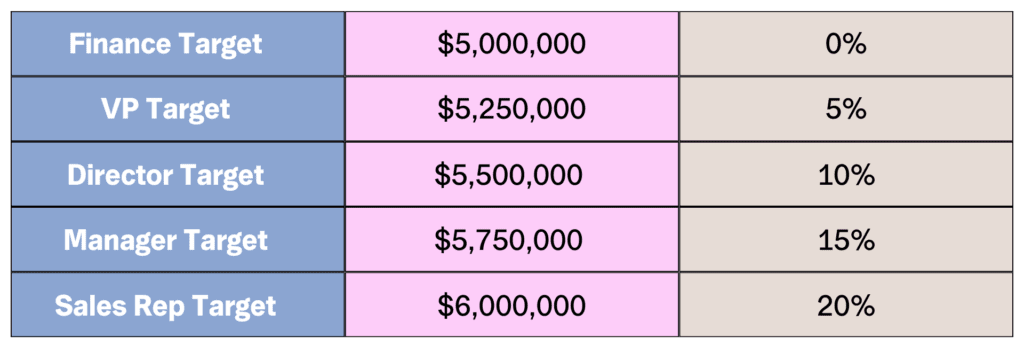In every organization, setting the right sales targets and quotas is fundamental to strategic planning. These elements are essential for directing the focus and behaviour of the sales teams. A misstep in this process can lead to missed objectives and higher attrition, while setting accurate targets and quotas creates a healthier sales organisation that’s achieving its goals. In this final instalment of our latest blog series, we explore the complex process of integrating targets and quotas into the top-down planning of organizations. We’ll examine the critical considerations and the methodologies that are vital for setting these benchmarks effectively. Understanding the nuances of this process is key to fostering a healthy, high-performing sales environment.
JUMP TO EACH SECTION TO LEARN MORE
Definition of sales targets and quotas
Sales targets are broader objectives for the sales strategy, aiming for longer-term achievements like market expansion or increased deal sizes. They set the direction for where the company wants to grow over the year.
Sales quotas are specific sales goals assigned to salespeople or teams for a set period (like monthly or quarterly), focusing on revenue, new accounts, or product volumes. They’re about hitting concrete numbers, with direct ties to incentives and performance.
In essence, targets align efforts with the bigger picture of strategic growth and quotas drive immediate hustle.
Understanding sales targets and quota planning
Understanding the distinction and interplay between targets and quotas is pivotal in the initial phase of your top-down planning process. Let’s demystify these terms, starting with targets.
Sales targets
Typically, global targets are established by the Finance team and are further distributed across various dimensions such as region, product line, type of business, etc. These global targets represent the financial goals the organization aims to achieve and are the figures publicly reported each quarter.
Chief Revenue Officers (CROs) are responsible for delivering on these numbers and Revenue Operations will help ensure the targets are distribution correctly across the sales organisation and are aligned to the strategic initiatives like growing a new product line or upselling additional product into the customer base.
Sales quota
Transitioning next to Quotas involves a two-step process.
Step one is a meticulously structured approach to determine the over-assignment ratio, which essentially uplifts the target figures from Finance at each managerial level, for example from Vice Presidents to Directors to Front line Sales Managers to Sales Reps.
This over-assignment ensures that the organization aims higher than its baseline financial target, driving ambition across the sales hierarchy and accommodating for potential shortfalls like people leaving the organisation or changes that need to be made due to strategic shifts within the business.
Illustrative breakdown of the over-assignment process:

You would generally want to aim for a 15-20% over-assignment, although this can vary significantly across different organizations and is influenced by factors such as the organization’s size and the sales structure complexity. However, organizational structures can complicate this straightforward allocation, with teams divided by business type (e.g., New Business, Upsell, Renewals) or product lines, each potentially requiring unique targets and over-assignment ratios.
These over assignments then translate these uplifted numbers into specific quotas for each role which are then assigned to the individuals.
Step two is determining your seasonality and how you distribute the quotas across the months and quarters for each year. You would generally follow how the business has previously come in, so for example if the prior Q1 bookings was 22% of the annual number then you could expect something similar in the next year. It’s not always easy to change and more than likely will need to be done incrementally so for example if you want Q1 to be 28% in a future year, then start by getting to 25% first. I would also advise to avoid the ‘hockey stick’ effect in the third month of each quarter and rather distribute the quotas more evenly across the months within the quarters so something like this 30%/30%/40%. You also need to factor in the holidays, etc as in Europe you would adjust July and August down to reflect the impact on the business. It’s therefore important to set your seasonality by region/country as it can be quite different depending on where you are in the world.
Illustrative breakdown of the seasonaility process:

Direct quota vs. indirect quota
We also need to factor in the supporting functions like Sales Engineers, Channel Managers and even Sales Development Reps for example. These roles are part of the overall sale team but do not have Direct quota and are rather set-up with indirect quota so they are aligned correctly to the teams they support and help drive the right behaviours.
These supporting functions are normally assigned a team of salespeople to support or even a whole region depending on the size of the organisation. The indirect quota assigned will be the total of the direct quota of these salespeople with an adjusted over assignment percentage.
You can see these quotas can very quickly get complicated to manage, especially with all the data moments that can happen with people coming and going, changing teams, changing roles, etc. These indirect quotas do not impact the overall target but will influence the direct quotas attainment.
Sales quotas and compensation
Compensation Plans play a crucial role in this equation as you need to link the quotas to the variable pay to calculate the commission rates. Ideally, commission rates hover between 10%-30%, balancing motivational incentives with organizational feasibility. Here’s a basic formula to elucidate this point:
Commission Rate = (Variable Component/Total Quota Value)×100
For instance, a $100,000 variable pay on a $500,000 quota equals a 20% commission rate. Setting quotas too high could result in lower commission rates, potentially fostering undesirable sales behaviors. Thus, it’s essential to strike a balance that motivates without overextending organizational resources or expectations. There are also accelerators that can be added to compensation plans that pay more for over achievement ie., hitting 110% of your quota. There can also be de-accelerators for underperformance ie. hitting 50% of your quota over a given period of time.

Why it's important
1. The impact of sales targets and quota planning in sales teams
- Critical role in sales behaviour: understanding the pivotal role of sales targets and quotas reveals their influence on sales team dynamics and the necessity for a robust sales organization.
- Measurement beyond achievement: the effectiveness of targets and quotas extends beyond mere attainment, significantly affecting the overall health of the sales environment.
2. Challenges of not meeting sales targets and quotas
- High attrition rates: consistent failure to meet sales numbers leads to increased turnover, incurring significant financial and operational costs. For example, onboarding a new mid-market salesperson costs an average of $295,000, underlining the economic implications.
- Strategic sales planning disruption: the departure of seasoned, fully ramped representatives creates gaps that new, ramping reps must fill, diluting the planned over-assignment percentage and affecting quota achievement
- Impact on management: this dilution risks the ability of direct line managers to meet their targets, potentially causing a domino effect up the management chain and risking widespread performance issues.
- Increased pressure: the need to frequently onboard new team members add strain on managers and the existing team, impacting resources and weakening team cohesion and morale.
- Difficulty in achieving Sales Targets: When attrition rates surpass 20%, it significantly hampers the ability to meet sales targets, marking a crucial point where the stability and performance of the sales organization are jeopardized.
3. The significance of realistic and motivating sales targets
- Foundation of Sales Success: Setting realistic, motivating targets and quotas is critical—they are more than mere numbers; they're essential indicators and catalysts for the health and success of the sales operation.
Linking quotas to sales productivity and efficiency
A prevalent challenge within sales organizations is the underutilization of sales productivity and efficiency metrics in determining targets and quotas. This oversight contributes to a concerning statistic: only 48% of salespeople meet their quotas.
As highlighted in our previous discussions on Sales Productivity, Sales Efficiency and Capacity Planning understanding and applying these metrics is crucial. By analyzing the actual achievements of the sales team, organizations can establish quotas based on a realistic ratio of sales productivity and efficiency. Ideally, you would like to see a 3-5x return for each salesperson meaning, if the cost is $250k per person per year, you would expect to see $750k to $1.25m back in bookings. These ratios vary depending on the business type as New business is harder than Upsell or Renewals so you would expect a lower return. You may also be entering a new market and are okay with a 1x return while you build the business.
Next step is to look at your sales productivity as if each salesperson is only delivering $480k on average per year, then setting quotas of $1.25m per person is unrealistic. A better approach would be to set the quotas as a ratio to the productivity and adjust the compensation rates to manage the cost.
This method stands in stark contrast to setting arbitrary or overly ambitious quotas without considering the team’s proven capacity and return on investment. By grounding quota setting in tangible performance data, organizations can create a more achievable benchmark for success. This approach not only fosters a healthier sales environment but also enhances the likelihood of a larger segment of the team meeting or exceeding their targets.
Ultimately, aligning quotas with sales productivity and cost data is a key strategy for boosting overall sales efficiency and achieving a high-performance sales organization.
Top ways to improve target and quota planning
Improving the planning process for targets and quotas is crucial for aligning sales efforts with broader business objectives and market realities. Here are the top strategies to consider:
1. Foster collaboration with finance
A strong partnership between the sales and finance departments ensures that targets and quotas are not only ambitious but also grounded in financial realities. This collaboration facilitates a balanced approach, combining sales aspirations with practical financial insights.
2. Anchor in sales productivity and efficiency
Quotas should reflect an understanding of current sales productivity and efficiency levels. By aligning targets with actual sales performance data, organizations can set more realistic and achievable goals, motivating sales teams through attainable challenges.
3. Embrace regular adjustments
The business landscape and market conditions are always in flux. Regularly revisiting and adjusting targets and quotas in response to these changes ensures that sales efforts remain relevant and focused. This adaptability prevents quotas from becoming outdated, keeping sales teams aligned with current business strategies and market opportunities. When I was at Citrix we used to change the quotas quarterly.
Implementing these strategies can significantly improve the effectiveness of target and quota planning, ensuring they serve as powerful tools for driving sales performance and business growth.
Insights from effective target and quota planning
So now that you know how to do effective target and quota planning, let’s review some of the key insights and benefits you gain.
1. Sales performance
- Analysis of the direct relationship between quota setting and sales performance, revealing how over-assignment and aggressive targets can affect the attainment and revenue projections.
- Insight into growth potential by assessing whether current sales performance and quota achievement are sustainable and support long-term business goals.
2. Operational efficiency
- Understanding the cost implications of turnover, including hiring and training expenses, against the backdrop of sales target planning.
- Insights into operational efficiency, with a focus on how the sales organization's structure and processes need to adapt to changing targets and quotas
3. Team alignment
- Insight into how well the sales team is aligned with the overall business objectives.
- Data on the efficiency of sales processes and the identification of potential bottlenecks or areas for streamlining efforts
Set sales targets and quotas that drive success and business growth
It’s clear that setting the right targets and quotas is crucial for any sales team’s success. They guide sales teams, help manage costs and keep everyone working towards the same goals. Through strategic selection and timely adjustments of targets and quotas, businesses can enhance sales performance, optimize expenditures, and ensure team alignment and productivity.
It’s about more than just hitting numbers; it’s about creating a strategy that moves the whole business forward. The world of sales is always changing, so our plans should too. Keeping up with this will help any business stay on track and thrive in the long run.
To learn more, request a demo, contact us or install a free 30-day trial from the Salesforce AppExchange today. We’d love to hear from you!


